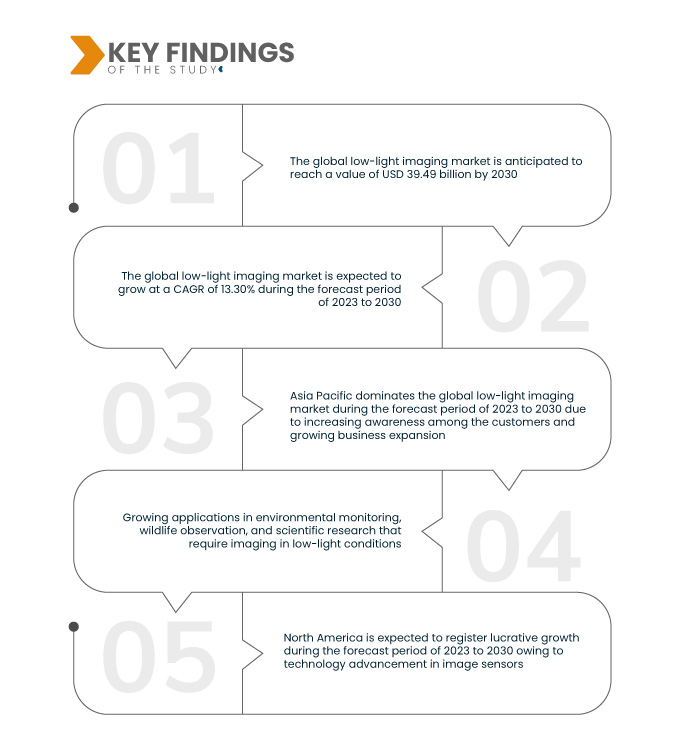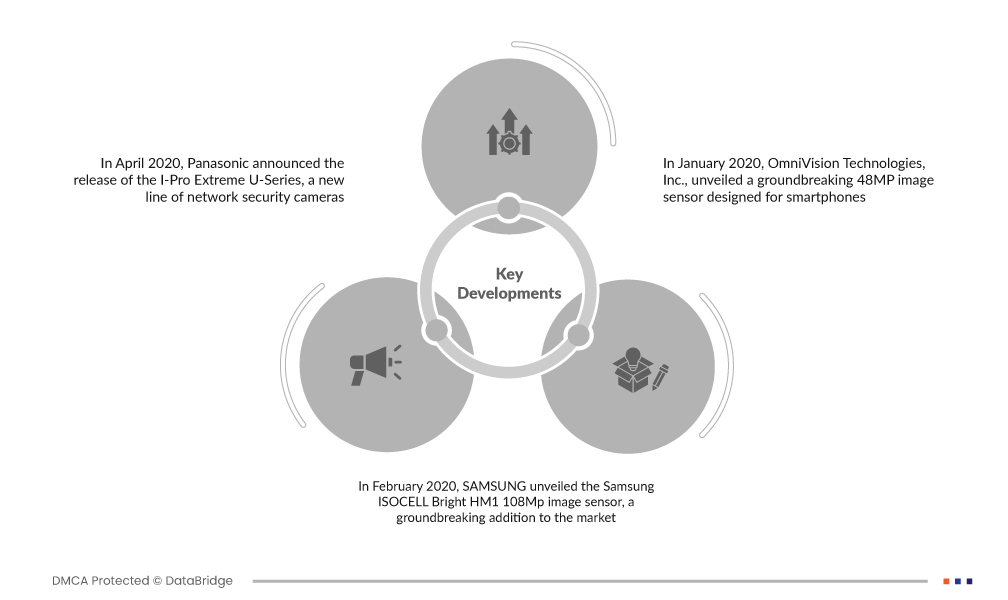글로벌 저조도 이미징 시장은 저조도 환경에 최적화된 이미징 솔루션을 개발하고 제공하는 데 중점을 두는 산업을 의미합니다. 센서 , 광학 장치, 그리고 이미지 처리 알고리즘을 통해 기존 카메라로는 감당하기 어려운 야간이나 어두운 환경에서도 가시성을 높이고 사용 가능한 이미지를 생성합니다. 이 기술은 감시, 천문학, 보안, 스마트폰 사진 촬영 등 다양한 분야에서 저조도 환경에서 이미지 품질을 향상시키는 데 널리 사용됩니다. 기술의 발전에 따라 저조도 이미징 시장은 더욱 확대될 것으로 예상되며, 까다로운 조명 조건에서도 선명하고 디테일한 이미지를 포착할 수 있는 혁신적인 솔루션을 제공할 것입니다.
https://www.databridgemarketresearch.com/reports/global-low-light-imaging-market 에서 전체 보고서를 확인하세요.
데이터 브리지 마켓 리서치(Data Bridge Market Research)에 따르면, 글로벌 저조도 이미징 시장은 2022년 145억 4천만 달러 규모였으며, 2030년까지 394억 9천만 달러 규모로 성장하여 2023년부터 2030년까지 연평균 13.30%의 성장률을 기록할 것으로 예상됩니다. 견고한 감시 솔루션에 대한 수요 급증은 글로벌 저조도 이미징 시장의 성장을 촉진하고 있습니다. 저조도 환경에서 효과적인 모니터링의 중요성은 첨단 이미징 기술의 광범위한 도입을 촉진하여 감시 산업에 향상된 가시성과 보안 역량을 제공합니다.
연구의 주요 결과
군사 및 방위 응용 분야가 시장 성장률을 견인할 것으로 예상됩니다.
군사 작전 및 방위 시스템에 저조도 영상 기술이 통합되는 추세는 상황 인식 향상에 중요한 진전을 의미합니다. 위협이 다양화됨에 따라 최첨단 저조도 영상 기술의 도입은 필수적입니다. 이러한 시스템은 군의 전술적 우위를 제공하여 까다로운 야간 환경에서도 효과적인 작전을 수행할 수 있도록 지원합니다. 어둠 속에서도 뛰어난 가시성에 대한 요구가 높아짐에 따라 저조도 영상 기술의 전략적 중요성이 더욱 부각되고 있으며, 이는 미래 군사 및 방위 역량의 지형을 형성할 것입니다.
보고서 범위 및 시장 세분화
보고서 메트릭
|
세부
|
예측 기간
|
2023년부터 2030년까지
|
기준 연도
|
2022
|
역사적인 해
|
2021 (2015-2020년으로 맞춤 설정 가능)
|
양적 단위
|
매출(10억 달러), 볼륨(단위), 가격(USD)
|
다루는 세그먼트
|
기술(보완 금속 산화막 반도체(CMOS) 및 전하 결합 소자(CCD)), 응용 분야(사진, 모니터링, 검사 및 탐지, 보안 및 감시), 수직 분야( 가전 , 자동차, 의료 및 생명 과학, 군사 및 방위, 산업, 상업 및 주거 인프라)
|
포함 국가
|
미국, 캐나다 및 멕시코(북미), 독일, 프랑스, 영국, 네덜란드, 스위스, 벨기에, 러시아, 이탈리아, 스페인, 터키, 유럽의 기타 유럽 국가, 중국, 일본, 인도, 한국, 싱가포르, 말레이시아, 호주, 태국, 인도네시아, 필리핀, 아시아 태평양(APAC)의 기타 아시아 태평양 국가(APAC), 사우디 아라비아, UAE, 남아프리카 공화국, 이집트, 이스라엘, 중동 및 아프리카(MEA)의 일부인 기타 중동 및 아프리카(MEA), 브라질, 아르헨티나 및 남미의 일부인 기타 남미
|
시장 참여자 포함
|
Panasonic Corporation Co, Ltd(일본), Samsung(대한민국), BAE Systems(영국), Andanta GmbH(독일), ams-OSRAM AG(오스트리아), STMicroelectronics(스위스), Sharp Corporation(일본), Teledyne FLIR LLC(미국), Hamamatsu Photonics KK(일본), Semiconductor Components Industries, LLC(미국), PIXELPLUS(아랍에미리트), OmniVision(미국, Sony Semiconductor Solutions Corporation(일본), ROHM CO., LTD.(일본), TE Connectivity.(스위스), Ushio America, Inc.(일본), Würth Elektronik GmbH & Co. KG(독일)
|
보고서에서 다루는 데이터 포인트
|
Data Bridge Market Research에서 큐레이팅한 시장 보고서에는 시장 가치, 성장률, 세분화, 지리적 범위, 주요 기업 등 시장 시나리오에 대한 통찰력 외에도 심층적인 전문가 분석, 지리적으로 대표되는 회사별 생산 및 용량, 유통업체 및 파트너의 네트워크 레이아웃, 자세하고 업데이트된 가격 추세 분석, 공급망 및 수요에 대한 부족 분석이 포함됩니다.
|
세그먼트 분석:
글로벌 저조도 이미징 시장은 기술, 응용 분야 및 수직 분야를 기준으로 세분화됩니다.
- 기술 기준으로 글로벌 저조도 이미징 시장은 CMOS(Complementary Metal-Oxide Semiconductor)와 CCD(Charge-Coupled Device)로 구분됩니다.
- 응용 프로그램을 기준으로 글로벌 저조도 이미징 시장은 사진, 모니터링, 검사 및 감지, 보안 및 감시로 세분화됩니다.
- 수직 기준으로 글로벌 저조도 이미징 시장은 가전 제품, 자동차, 의료 및 생명 과학, 군사 및 방위, 산업, 상업 및 주거 인프라로 세분화됩니다.
주요 플레이어
Data Bridge Market Research는 글로벌 저조도 이미징 시장의 주요 글로벌 저조도 이미징 시장 참여자로 다음 회사를 인식합니다. PIXELPLUS(UAE), OmniVision(미국), Sony Semiconductor Solutions Corporation(일본), ROHM CO., LTD.(일본), TE Connectivity(스위스), Ushio America, Inc.(일본), Würth Elektronik GmbH & Co. KG(독일)
시장 개발
- 2020년 4월, 파나소닉은 새로운 네트워크 보안 카메라 라인인 I-Pro Extreme U-시리즈를 출시했습니다. 주야간 모두 원활하게 작동하도록 특별히 설계된 이 카메라는 IR-LED 기술을 탑재했습니다. 뛰어난 저조도 성능으로 까다로운 조명 환경에서도 선명한 컬러 이미지와 고품질 보안을 보장합니다. 이번 출시는 다양한 조명 조건에서 효과적인 감시 및 모니터링을 위한 첨단 솔루션을 제공하려는 파나소닉의 노력을 보여줍니다.
- 2020년 2월, 삼성은 시장에 획기적인 변화를 가져올 삼성 ISOCELL Bright HM1 1억 800만 화소 이미지 센서를 출시했습니다. 저조도 환경에서 8K 이미지 촬영을 위해 설계된 이 센서는 크로스토크 감소, 광학 손실 최소화, 빛 반사 감소 등의 장점을 자랑합니다. 이 혁신적인 제품 출시를 통해 삼성은 글로벌 시장 점유율을 더욱 강화하고, 경쟁이 치열한 이미지 센서 기술 분야에서 기술적 한계를 뛰어넘겠다는 의지를 보여주었습니다.
- 2020년 1월, OmniVision Technologies, Inc.는 스마트폰용으로 설계된 획기적인 48MP 이미지 센서를 선보였습니다. 이 혁신적인 센서는 탁월한 저조도 성능, 4k2k 비디오에 최적화된 출력, 그리고 고해상도 정지 이미지 촬영을 보장합니다. 이 최첨단 제품의 출시를 통해 OmniVision은 탁월한 저조도 성능에 특화된 이미지 센서 포트폴리오를 강화하여 시장 입지를 강화할 것입니다. 이러한 전략적 행보를 통해 OmniVision은 역동적인 스마트폰 시장에서 증가하는 고급 이미징 솔루션 수요를 충족할 수 있는 입지를 확보하게 되었습니다.
지역 분석
지리적으로 글로벌 저조도 이미징 시장 보고서에서 다루는 국가는 북미의 미국, 캐나다 및 멕시코, 독일, 프랑스, 영국, 네덜란드, 스위스, 벨기에, 러시아, 이탈리아, 스페인, 터키, 유럽의 기타 유럽, 중국, 일본, 인도, 한국, 싱가포르, 말레이시아, 호주, 태국, 인도네시아, 필리핀, 아시아 태평양(APAC)의 기타 아시아 태평양(APAC), 사우디 아라비아, UAE, 남아프리카, 이집트, 이스라엘, 중동 및 아프리카(MEA)의 일부인 기타 중동 및 아프리카(MEA), 브라질, 아르헨티나 및 남미의 일부인 기타 남미입니다.
Data Bridge Market Research 분석에 따르면:
아시아 태평양 지역 은 2023-2030년 예측 기간 동안 글로벌 저조도 이미징 시장 에서 지배적인 지역입니다 .
아시아 태평양 지역은 일본의 영향력 있는 역할에 힘입어 세계 저조도 이미징 시장을 장악하고 있습니다. 삼성과 소니 세미컨덕터 솔루션즈 코퍼레이션과 같은 주요 기업들은 상당한 수의 이미지 센서를 생산하며 상당한 기여를 하고 있습니다. 일본은 고객 인지도 향상과 사업 확장에 힘입어 이 지역의 성장을 선도하고 있습니다. 혁신적인 이미징 솔루션에 대한 집중은 아시아 태평양 지역, 특히 일본을 역동적인 저조도 이미징 기술 환경 속에서 매출 성장의 선두주자로 자리매김하게 합니다.
북미는 2023-2030년 예측 기간 동안 글로벌 저조도 이미징 시장 에서 가장 빠르게 성장하는 지역으로 추정됩니다.
북미 지역은 2023년부터 2030년까지 세계 저조도 이미징 시장을 주도하며 가장 빠르게 발전하는 지역으로 부상할 것으로 예상됩니다. 이러한 우세는 주로 이미지 센서 분야의 급속한 기술 발전에 기인합니다. 북미 지역의 혁신에 대한 헌신은 최첨단 저조도 이미징 기술 도입을 촉진하여 성장을 촉진합니다. 특히 이미지 센서 분야의 연구 개발 활동 급증은 북미 지역을 저조도 이미징 기술 발전을 선도하는 지역으로 자리매김하게 합니다.
글로벌 저조도 이미징 시장 보고서 에 대한 자세한 내용은 여기를 클릭하세요 - https://www.databridgemarketresearch.com/reports/global-low-light-imaging-market












